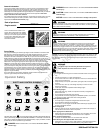
4 BRIGGSandSTRATTON.COM
General Information
This manual contains safety information to make you aware of the hazards and risks
associated with engines and how to avoid them. It also contains instructions for the
proper use and care of the engine. Because Briggs & Stratton Corporation does not
necessarily know whatequipment this enginewill power, it isimportant that you readand
understand these instructions and the instructions for the equipment. Save these
original instructions for future reference.
For replacement partsor technical assistance, record belowthe engine model, type, and
code numbers along with the date of purchase. These numbers are located on your
engine (see the Features and Controls page).
Date of purchase:
Engine model:
MM/DD/YYYY
Model: Code:Ty pe:
Look for the 2D barcode located on the
engine. When viewed with a 2D--capable
device, the code will bring up our website
where you can access support information
for this product. Data rates apply. Some
countries may not have online support
information available.
Power Rating
The gross power rating for individual gas engine models is labeled inaccordance with
SAE (Society of Automotive Engineers) code J1940 (Small Engine Power& Torque
Rating Procedure), and rating performance has been obtained and correctedin
accordance with SAE J1995 (Revision 2002--05). Torque values are derived at 3060
RPM; horsepower values are derived at 3600 RPM. The gross power curves can be
viewed at www.BRIGGSandSTRATTON.COM. Net power values are taken with exhaust
and air cleaner installed whereas gross power values are collected without these
attachments. Actual gross engine power will be higher than net engine powerand is
affected by, among other things, ambient operating conditions and engine--to--engine
variability. Given the widearray of products onwhich engines are placed,the gas engine
may not develop the rated gross power when usedin a given piece of power equipment.
This difference is due to a variety of factors including, but not limited to, the variety of
engine components (air cleaner, exhaust, charging, cooling, carburetor, fuel pump, etc.),
applicationlimitations, ambientoperating conditions(temperature, humidity,altitude),and
engine--to--engine variability.
Due to manufacturing and capacity limitations, Briggs & Stratton may substitute an
engine of higher rated power for this Series engine.
Operator Safety
Explosion
Toxic Fumes
Moving Parts
Shock
Hot Surface
Kickback
Fire
Fuel Shutoff
Read Manual
Choke
Oil
Fuel
On Off
Stop
Wear Eye
Protection
Slow
Fast
SAFETY AND CONTROL SYMBOLS
Hazardous
Chemical
Frostbite
The safety alert symbol is used to identify safety information about hazards that can
result in personal injury. A signal word (DANGER, WARNING, or CAUTION) is used with the
alert symbol to indicate thelikelihood and the potential severity of injury. In addition, a hazard
symbol may b e used to represent the type of hazard.
DANGER indicates a hazard which, if not avoided, will result in death or
serious injury.
WARNING indicates a hazard which, if not avoided, could result in deathor
serious injury.
CAUTION indicates a hazard which, if not avoided, could result in minor or
moderate injury.
NOTICE indicates a situation that could result in damage to the product.
WARNING
Certain components in this product and its related accessories contain chemicals
known to the State of California to cause cancer, birth defects, or other reproductive
harm. Wash hands after handling.
WARNING
The engine exhaust from this product contains chemicals known to the State of
California to cause cancer, birth defects, or other reproductive harm.
WARNING
Briggs & Stratton Engines are not designed for and are notto be used to power:
fun-karts; go-karts; children’s, recreational, or sport all-terrain vehicles (ATVs);
motorbikes; hovercraft; aircraft products; or vehicles used in competitive events not
sanctioned by Briggs & Stratton. For information about competitive racing products,
see www.briggsracing.com. Foruse with utilityand side-by-side ATVs, please contact
Briggs & Stratton Engine Application Center, 1-866-927-3349. Improper engine
application may result in serious injury or death.
NOTICE: This engine was shipped from Briggs & Stratton without oil. Before you start
the engine, make sure you add oil according to the instructions in this manual. If you
start the engine without oil, it will be damaged beyond repair and will notbe covered
under warranty.
WARNING
Fuel and its vapors are extremely flammable and explosive.
Fire or explosion can cause severe burns or death.
When Adding Fuel
Turn engineoff and let enginecool atleast2 minutesbeforeremoving thefuel
cap.
Fill fueltank outdoors orin well-ventilated area.
Do not over fill fuel tank. To allow for expansion of the fuel, do not fill above the
bottom of the fuel tank neck.
Keepfuel awayfromsparks, openflames,pilot lights,heat,and otherignition
sources.
Check fuellines, tank, cap, andfittings frequently forcracks or leaks.
Replace ifnecessary
If fuel spills, wait until it evaporates before starting engine.
When Starting Engine
Ensure that spark plug, muffler, fuel cap and air cleaner (if equipped) are in
place and secured.
Do not crank engine with spark plug removed.
If engine floods, set choke (if equipped) to OPEN/RUN position, move throttle
(if equipped) to FAST position and crank until engine starts.
When Operating Equipment
Do not tip engine or equipment at angle which causes fuel to spill.
Do not choke the carburetor to stop engine.
Never start or run the engine with the air cleaner assembly (if equipped) or the
air filter (if equipped) removed.
When Changing Oil
When you drain the oil from the top oil fill tube, the fuel tank must be empty or
fuel can leak out and result in a fire or explosion.
When Tipping Unit for Maintenance
When performing maintenance that requires the unit to be tipped, the fuel tank
must be empty or fuel can leak out and result in a fire or explosion.
When Transporting Equipment
Transport with fuel tank EMPTY or with fuel shut-off valve OFF.
When Storing Fuel Or Equipment With Fuel In Tank
Store away from furnaces, stoves, water heaters or other appliances that have
pilot lights or other ignition sources because they can ignite fuel vapors.
Not for
Reproduction


















